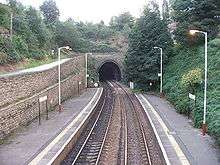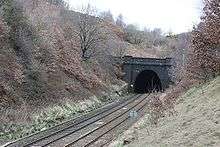Morley Tunnel
Morley Tunnel is a railway tunnel in West Yorkshire, England, situated between Morley and Batley railway stations on the Huddersfield Line. From its northern end (53.7490°N 1.5927°W), it extends 3,369 yards (3,081 m), passing beneath Morley town centre, to its southern end (53.7260°N 1.6192°W).


History
The construction of Morley Tunnel began in 1845. The first stone was laid on 23 February 1846 by John Gott, the chairman of the Leeds, Dewsbury and Manchester Railway.[1] The tunnel was finally completed in 1848, when the last keystone was placed at the Morley end of the tunnel by Mr. Granger, the principal engineer. The completion of the tunnel created much excitement around the town, and a band marked this occasion when it played at the event. The completion of the tunnel provided a much needed rail link between Yorkshire and Lancashire. During construction, 23 working shafts were sunk in addition to the four permanent vent/construction shafts still in use today at Town End, Hopewell Farm, America Moor and Howley Park. At one time, men worked at 48 different points along the length of the tunnel. This was made possible by using steam engines to lower men down the working shafts to the level of the tunnel and raising stone and clay to the surface.
To construct the tunnel, 11 powerful steam engines, 15 double horse gins, 2000 men and 350 horses were used, and the work caused a huge change to the then known landscape, particularly in the area where Morley Low station is situated, where a huge cutting had to be excavated and the valley stream had to be culverted. At its deepest point the tunnel is 400 feet below ground level. It is almost level throughout its length except for a slight gradient to allow for drainage. The tunnel is 26 feet (7.9 m) high and 26 feet wide to accommodate two tracks.
Along the course of the tunnel, tons of sandstone and clay were excavated and raised to the surface via construction shafts and dumped on spoil heaps, two of which were by the Townend shaft on South Queen Street and Melbourne Street. St Pauls Church, which stands on South Queen Street, was known as "the church on the spoil heap", as the hill it stands on is not a natural hill but the spoil heap of Morley Railway Tunnel.
Much of the sandstone brought to the surface was used as building material, and King Brickworks, which was located near to where The Fountain public house is today, produced bricks from the excavated sandstone. Much of the sandstone not suitable for this was used in road building.
Today
Today, the tunnel is used by the local services run by Northern and the long distance services between Leeds and Manchester Piccadilly by TransPennine Express.
References
- Baines, Thomas (1870). Yorkshire, past and present: Vol.2. London: W. Mackenzie. p. 452. Retrieved 18 April 2020.